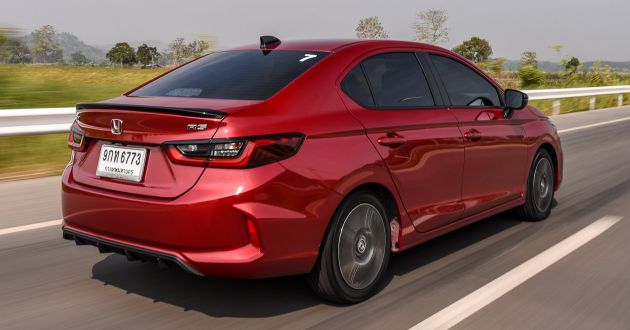To say that the 2020 Honda City has garnered much fanfare would be quite understating it, seeing as it was one of the hottest launch stories of 2019, at least as non-national models go. Its closest rival for the time being would be the 2020 Nissan Almera, a completely revamped B-segment sedan that also comes with a turbocharged three-cylinder engine.
Just to recap, the City Turbo RS is powered by a 1.0 litre (998 cc) VTEC Turbo engine, delivering a healthy 122 PS at 5,500 rpm and 173 Nm of torque from 2,000 to 4,500 rpm. It’s front-wheel drive only, and in Thailand a CVT gearbox with seven virtual speeds is the only transmission on offer.
The suspension setup remains the same as before, with MacPherson struts being used at the front, while a torsion beam is found in the rear axle. The same applies to the brake system, with ventilated discs up front, while drums are used for the rear.
Dimensions-wise, the new City is 113 mm longer (4,553 mm) and 53 mm wider (1,748 mm) than its predecessor, but gets a 10 mm decrease in height (1,467 mm) and a wheelbase that is 11 mm shorter (2,589 mm). Despite the shorter wheelbase, there’s actually more leg room and knee clearance, thanks to the reprofiled rear seats.
The car’s design remains a subjective topic, but most of us writers seem to find it visually appealing, though perhaps not quite as sleek as the Almera. Honda says NVH has been improved, thanks to polyurethane spray foam insulation and a thicker engine under cover insulator.
The cabin features an entirely new dashboard design, with slight hints of the new Jazz (not such a bad thing, really). There’s an off-centred infotainment display, vertical-style air vents, new steering wheel design with a smaller centre boss, as well as a generally tidier cockpit that’s more pleasant to the eyes.
Further down the centre console is where it starts feel somewhat similar, although there are now additional buttons beside the gear lever for enabling or disabling the car’s Econ mode and engine idling function.
Things get a little less rosy on the safety side of things. For one, there’s no autonomous emergency braking (AEB), but Thai rules mandate the fitment of ABS, EBD, BA and VSA as standard, so all variants sold in the Kingdom will get those at the very least.
The 2020 Honda City is currently being test driven by the Thai media in Chiang Rai, where this batch of photos were taken. Prices for the B-segment sedan starts from 579,500 baht (RM77,534), with four variants – S, V, SV and RS – offered to customers there. Anyone still excited for this?










Tinggalkan komen anda